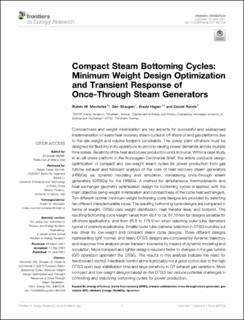| dc.contributor.author | Mocholí Montañés, Rubén | |
| dc.contributor.author | Skaugen, Geir | |
| dc.contributor.author | Hagen, Brede | |
| dc.contributor.author | Rohde, Daniel | |
| dc.date.accessioned | 2021-09-24T07:42:43Z | |
| dc.date.available | 2021-09-24T07:42:43Z | |
| dc.date.created | 2021-05-18T12:29:34Z | |
| dc.date.issued | 2021 | |
| dc.identifier.citation | Frontiers in Energy Research. 2021, 9, . | en_US |
| dc.identifier.issn | 2296-598X | |
| dc.identifier.uri | https://hdl.handle.net/11250/2781299 | |
| dc.description.abstract | Compactness and weight minimization are key aspects for successful and widespread implementation of waste heat recovery steam cycles in off-shore oil and gas platforms due to the site weight and volume footprint constraints. The power plant off-shore must be designed for flexibility in its operations to provide varying power demands across multiple time scales. Reliability of the heat and power production units is crucial. Within a case study in an off-shore platform in the Norwegian Continental Shelf, this paper conducts design optimization of compact and low weight steam cycles for power production from gas turbine exhaust and transient analysis of the core of the heat recovery steam generator (HRSG) s via dynamic modeling and simulation, considering once through steam generators (OTSG) for the HRSGs. A method for simultaneous thermodynamic and heat exchanger geometry optimization design for bottoming cycles is applied, with main objective being weight minimization and compactness of the cycle heat exchangers. Ten different optimal minimum weight bottoming cycle designs are provided by selecting ten different manufacturable tubes. The resulting bottoming cycle designs are compared in terms of weight, OTSG core weight distribution, heat transfer area and footprint. The resulting bottoming cycle weight varies from 48,4 ton to ca 87,10 ton for designs sensible for off-shore applications, and from 95,8 to 178,9 when selecting outer tube diameters typical of onshore applications. Smaller outer tube diameter selection in OTSG bundles is a key driver for low weight and compact steam cycle designs. Three different designs representing, light, normal and heavy OTSG designs are compared by dynamic trajectory and response time analysis under transient scenarios by means of dynamic modeling and simulation. More compact and lighter designs respond faster to changes in the gas turbine (GT) operation upstream the OTSG. The results in this analysis indicate the need for feedforward control. Feedback control only is probably not a good option due to the high OTSG open loop stabilization time and large sensitivity to GT exhaust gas variations. More compact and low weight designs based on OTSG can potentially result in challenging to control and stabilize bottoming cycles for power production. | en_US |
| dc.language.iso | eng | en_US |
| dc.publisher | Frontiers Media | en_US |
| dc.rights | Navngivelse 4.0 Internasjonal | * |
| dc.rights.uri | http://creativecommons.org/licenses/by/4.0/deed.no | * |
| dc.title | Compact steam bottoming cycles: minimum weight design optimization and transient response of once through steam generators | en_US |
| dc.type | Peer reviewed | en_US |
| dc.type | Journal article | en_US |
| dc.description.version | publishedVersion | en_US |
| dc.source.volume | 9 | en_US |
| dc.source.journal | Frontiers in Energy Research | en_US |
| dc.identifier.doi | 10.3389/fenrg.2021.687248 | |
| dc.identifier.cristin | 1910482 | |
| dc.relation.project | Norges forskningsråd: 280713 | en_US |
| dc.source.articlenumber | 687248 | en_US |
| cristin.ispublished | true | |
| cristin.fulltext | original | |
| cristin.qualitycode | 1 | |

